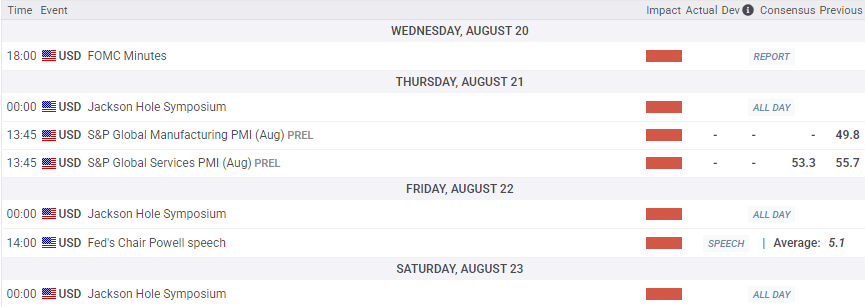Dow Jones Industrial Average cools on a quiet Monday

- The Dow Jones eased further below 45,000 to start the new week.
- Equities are taking a breather after last week’s bullish showing.
- A quiet start to the week gives way to this year’s Jackson Hole symposium.
The Dow Jones Industrial Average (DJIA) eased slightly on Monday, paring last week’s gains. A quiet start to the week is giving investors some room to breathe before the next round of key economic data, as well as the start of this year’s economic symposium at Jackson Hole.
The Dow Jones clipped into fresh all-time highs last week, reaching a record peak of 45,277 before easing back below 45,000. Despite cooling bullish pressure, the Dow is still holding steady on the high end, trading well above the 50-day Exponential Moving Average (EMA) near 43,920.
Central bank policy to get a front seat this week
Investors are getting an easy start, with little of note on the data docket through the front half of the trading week. Meeting Minutes from the Federal Reserve’s (Fed) latest interest rate decision will be released on Wednesday, but the key events this week will be S&P Global Purchasing Managers Index (PMI) survey results for August, slated for Thursday. The annual Jackson Hole Economic Policy Symposium hosted by the Fed Bank of Kansas City also kicks off this Thursday, and traders should expect soundbites and headlines to leak out of the policy shindig through the bottom half of the trading week. Fed Chair Jerome Powell will speak at Jackson Hole on Friday.

US inflation data sparked some fresh concerns among global markets last week, however, overall investor sentiment is still pricing in a Fed rate cut on September 17. According to the CME’s FedWatch Tool, rate traders are pricing in over 80% odds of at least a quarter-point rate cut next month, with nearly 90% odds of a follow-up cut in December.
Dow Jones daily chart

Dow Jones FAQs
The Dow Jones Industrial Average, one of the oldest stock market indices in the world, is compiled of the 30 most traded stocks in the US. The index is price-weighted rather than weighted by capitalization. It is calculated by summing the prices of the constituent stocks and dividing them by a factor, currently 0.152. The index was founded by Charles Dow, who also founded the Wall Street Journal. In later years it has been criticized for not being broadly representative enough because it only tracks 30 conglomerates, unlike broader indices such as the S&P 500.
Many different factors drive the Dow Jones Industrial Average (DJIA). The aggregate performance of the component companies revealed in quarterly company earnings reports is the main one. US and global macroeconomic data also contributes as it impacts on investor sentiment. The level of interest rates, set by the Federal Reserve (Fed), also influences the DJIA as it affects the cost of credit, on which many corporations are heavily reliant. Therefore, inflation can be a major driver as well as other metrics which impact the Fed decisions.
Dow Theory is a method for identifying the primary trend of the stock market developed by Charles Dow. A key step is to compare the direction of the Dow Jones Industrial Average (DJIA) and the Dow Jones Transportation Average (DJTA) and only follow trends where both are moving in the same direction. Volume is a confirmatory criteria. The theory uses elements of peak and trough analysis. Dow’s theory posits three trend phases: accumulation, when smart money starts buying or selling; public participation, when the wider public joins in; and distribution, when the smart money exits.
There are a number of ways to trade the DJIA. One is to use ETFs which allow investors to trade the DJIA as a single security, rather than having to buy shares in all 30 constituent companies. A leading example is the SPDR Dow Jones Industrial Average ETF (DIA). DJIA futures contracts enable traders to speculate on the future value of the index and Options provide the right, but not the obligation, to buy or sell the index at a predetermined price in the future. Mutual funds enable investors to buy a share of a diversified portfolio of DJIA stocks thus providing exposure to the overall index.







